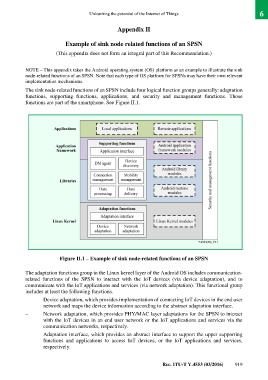Page 933 - Unleashing the potenti al of the Internet of Things
P. 933
Unleashing the potential of the Internet of Things 6
Appendix II
Example of sink node related functions of an SPSN
(This appendix does not form an integral part of this Recommendation.)
NOTE – This appendix takes the Android operating system (OS) platform as an example to illustrate the sink
node-related functions of an SPSN. Note that each type of OS platform for SPSNs may have their own relevant
implementation mechanisms.
The sink node-related functions of an SPSN include four logical function groups generally: adaptation
functions, supporting functions, applications, and security and management functions. Those
functions are part of the smartphone. See Figure II.1.
Figure II.1 – Example of sink node-related functions of an SPSN
The adaptation functions group in the Linux kernel layer of the Android OS includes communication-
related functions of the SPSN to interact with the IoT devices (via device adaptation), and to
communicate with the IoT applications and services (via network adaptation). This functional group
includes at least the following functions.
– Device adaptation, which provides implementation of connecting IoT devices in the end user
network and maps the device information according to the abstract adaptation interface.
– Network adaptation, which provides PHY/MAC layer adaptations for the SPSN to interact
with the IoT devices in an end user network or the IoT applications and services via the
communication networks, respectively.
– Adaptation interface, which provides an abstract interface to support the upper supporting
functions and applications to access IoT devices, or the IoT applications and services,
respectively.
Rec. ITU-T Y.4553 (03/2016) 919

